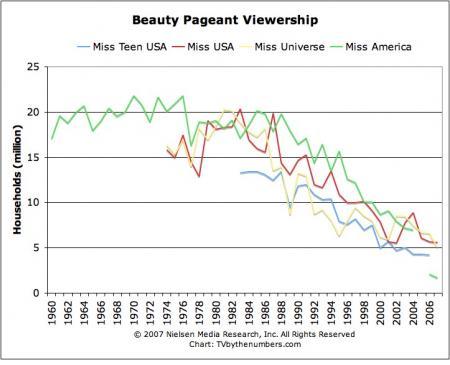What The Miss USA Pageant Says About Us
 i am completely disgusted that she would do this for free
i am completely disgusted that she would do this for free
And that's why it is ridiculously obvious that when the Miss USA Organization, co-owned by Trump and NBC television, released a racy video lingerie photo shoot of this year's contestants... the sole purpose was to pump up the ratings for this Sunday night's telecast of the 2010 pageant on NBC.
No.
 This past pageant got 6.6M, which is the same as last year.
This past pageant got 6.6M, which is the same as last year.
You may be tempted to think that these scandals are blown up in the media in order to boost ratings for the pageant. Yet while everyone knows about the controversies, you can't find one person (other than me) who actually watched the pageant. The marketing has all failed, from Vanessa Williams to Carrie Prejean. Why would they think seeing half naked women in lingerie would entice me to want to watch them fully clothed? Whoops?
IIa.
The photos seemed designed to generate controversy and buzz about the pageant, TODAY's Matt Lauer suggested to pageant president Paula Shugart. "Yes, to some degree it's marketing," Shugart admitted
Wrongolongoria. The controversy isn't to get viewers to watch the Pageant, the controversy is to get viewers to watch the Today Show.
Shows don't operate on their own, they're soldiers in a standing army. Miss USA is run by the Miss Universe Organization, owned by Donald Trump and NBC Universal, which is co-owned by GE and Vivendi. That means the Miss USA pageant can be enjoyed as a loss leader for MSNBC, NBC, USA Network, Bravo, A&E, Hulu, Activision/Blizzard, and Universal Studios.
And rival media is free to capitalize on it if they want. Oh, is she Muslim? Then off to Fox News and Glen Beck and etc. You think CBS is talking about it because they want to boost NBC's ratings?
Whenever someone talks about a television's show's ratings as if they have valuable information, punch them in the mouth.
IIb.
Small aside: if the game is eyeballs, then it becomes less relevant that they get the facts straight once you are watching; only that you watch.

Is this what the Miss USA represents? It used to be all -American girls, the leaders of the future. These are the leaders of the future?
III.
CBS News, unaffiliated with the pageant but hey, it's news, right? gets to ask, "Are Rima Fakih's Sexy Shots [of her in the stripping contest] Any Worse Than The Lingerie Photos?"
The answer, obviously, is yes, they are worse, they are much worse, and by worse I mean much better. If I have only one click left, I wanna see the stripper pole. Lingerie? What is this, the set of Falcon Crest? Bring on the pole.
"Americans are a puritanical lot that can't handle sexuality." Oh, no, they handle it just fine, otherwise it wouldn't be everywhere. They just can't handle it when they're with other people.
When you're by yourself and the sex scene in a rated R movie comes on, do you change the channel? "It seems wrong to watch the expression on her face change as she mounts him. I choose to turn away."
But with every passing year of marriage those scenes frustrate, you try to avoid them. Not when you're Alone, of course, but when you're watching with your spouse: you worry it is reminding them how inadequate you have become.
It happens also when you're with people you're not intimate with. Are they watching how you are watching it? If you're too interested, will they think you're a pervert, and if you appear bored, will they think you're a prude? So there's dead silence as everyone in the room pretends they're not pretending.
The word for all of this is shame.
It's perfectly normal to feel this way. But you chose this world, this is the one you wanted. What kind of a world is it where we want sexuality in everything, have normalized sexuality in everything, but are ashamed to be caught looking at it?
A world that prefers to be alone, of course.
IV.
A quick word on the homosexualization of public sexuality, or, what's up with all the naked guys in ads and movies nowadays? Is everyone gay? No. Otherwise it wouldn't work.
When a guy gets caught watching a naked girl in a movie, he's got some pretending or explaining to do. When a guy gets caught looking at a naked guy in a movie, he still gets the signifier of sexuality to use any way he wants, but without the shame. That the ladies might like it is an added plus.
 Son of a bitch... Posh Spice is smoking hot
Son of a bitch... Posh Spice is smoking hot
V.
There's a simple reason why the stripping pics are "worse" than the lingerie pics: she was told to pose in lingerie; she chose to strip on her own.
If there is one thing that makes Americans-- or at least the media, which both reflects and creates American tastes-- nervous, it isn't sex, but sex that it can't control.
Maybe it's a uniquely American thing, maybe not: as long as sex/iness comes with a price tag, we're ok with it. Controlled, manufactured, artificial-- safe. Lingerie shoot? "She had to do that for the pageant." Oh, so that's the answer. It's not real.
But if she's caught stripping for fun, then... what does that say about me?
The feminist argument is it sets a standard for women that they are forced to at least wonder about. "How can I compete?" But it's worse for men. Playboy is fine. Girls Gone Wild drives us bananas. "They do it... for nothing? They're willing to get naked on camera for nothing... yet every time I try to be nice and buy one of them a drink, they won't even look at me... I don't get it, I don't get it..."
Wanton displays of sexuality leave no room for rationalizations. "That kind of girl only wants a rich guy." But she did it for free. So?
America tends to be deferential to prostitutes and porn stars, because it understands them. It's powerless against sluts.
Which is why we call them sluts in the first place.



















Comments
05/18/2010 - 11:25.
I seem to remember that not too long ago NY City wanted anyonewho was shooting with a tripod and any type of still camera on any city property (sidewalks, etc) to take out one million dollars in insurance. The city was trying to claim that anyone one with a tripod must be a 'professional' photographer and therefore should be held to the same liability requirements. After a lot of fight that decision was repeeled, thankfully. The thing is - this director may have made his comment in the NY Times - but furthering this type of commentary (ie. spreading it around the internet) only makes me wonder when the city will try again. Maybe this time they can try to enforce that anyone shooting with a DSLR in public must purchase insurance. While what he says is true - Not so sure I'd be tossing around this brilliant quote. I, for one, am sick of being held up by movie sets walking around the city. And, really can you hide the movie crew/actors, etc as easily as you can disguise the camera? Eventually somebody's going to catch on and the rest of us will get to pay for it everytime we want a snapshot on the great streets of old NY.
Post new comment